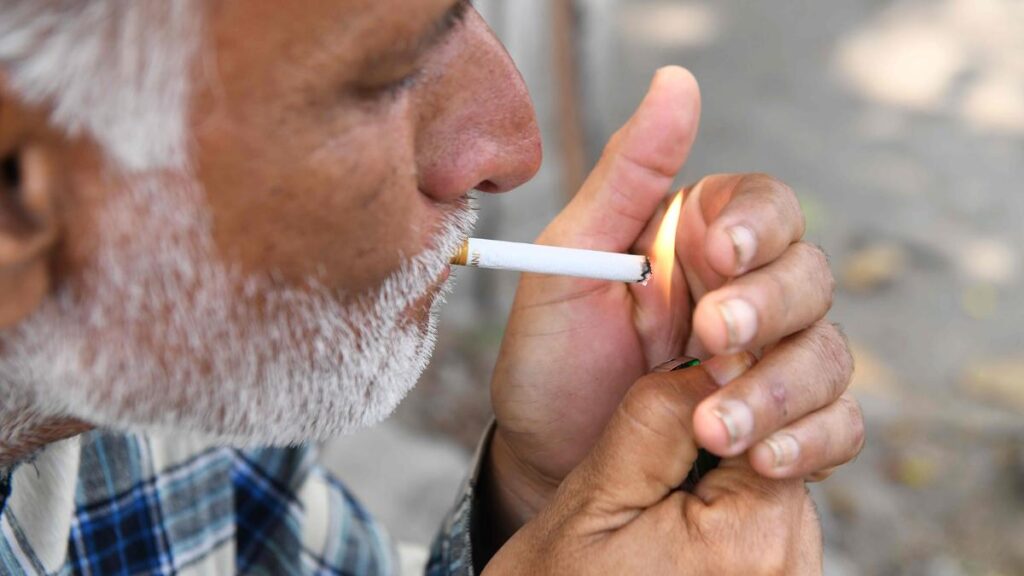
Changes in cigarette design and the addition of new chemicals may have altered their carcinogenic properties, say experts. Photograph used for representational purposes only. File photograph.
| Photo Credit: AFP
In 1999, Justice K. Narayana Kurup of the Kerala High Court delivered a landmark verdict banning smoking in public places, declaring it a violation of the fundamental right to life under Article 21 of the Constitution. This judgment laid the foundation for stricter tobacco control policies in India, influencing the Supreme Court’s ruling in Murli S. Deora vs. Union of India later that year, which paved the way for the Cigarettes and Other Tobacco Products Act (COTPA), 2003 formally prohibiting smoking in public places and introducing penalties for violations.
A quarter-century later, the effectiveness of these legal measures remains a subject of scrutiny, with experts stating that enforcement gaps continue to exist, changing smoking patterns pose new challenges, and the long-term health impact of tobacco use continues to remain a cause of grave concern.

Tobacco use, smoking and cancer
The Global Adult Tobacco Survey (GATS) 2016-17 states that the overall tobacco use prevalence in India declined from 34.6% in 2009-10 to 28.6% in 2016-17. Smoking prevalence among adults also decreased during the same period.
Despite this decline, data from the National Cancer Registry Programme (NCRP) under the Indian Council of Medical Research (ICMR) reveals that lung and oral cancers remain among the most prevalent malignancies in India. The ICMR-NCRP 2020 report estimated that approximately 27.5% of all cancer cases in men were linked to tobacco use, with over 1.3 million new cancer cases reported in India in 2020. While smoking prevalence has declined, NCRP data indicates that cumulative exposure to tobacco over a lifetime remains a key determinant of cancer risk.
The effects of smoking cessation on cancer rates take time to manifest, says Tanweer Shahid, Senior Consultant and Head of the Department of Radiation Oncology at Apollo Hospitals, Kolkata. “It takes years for the full impact of smoking cessation to be seen in cancer rates, as the disease development process involves a lag period between quitting and visible health outcomes,” he explains. Despite restrictions on smoking in public areas, many former public smokers continue the habit in private settings, maintaining their risk of tobacco-related diseases.
Cancer experts emphasise that smoking patterns alone do not determine cancer rates. Other contributing factors such as genetics, diet, family history, and environmental exposures also play a role. “Once someone has been a smoker for a significant period, their risk of developing smoking-related cancers remains elevated even after quitting,” says Dr. Shahid, highlighting the long-term health risks associated with smoking history.
Concerns also persist regarding the composition of modern cigarettes. Changes in cigarette design and the addition of new chemicals may have altered their carcinogenic properties, notes Koushik Muthu Raja Mathivanan, Professor of Pulmonary Medicine, Sri Ramachandra Medical College and Hospital, Chennai. “Modern cigarettes may contain different chemicals that could be equally or even more carcinogenic than older cigarettes, potentially impacting cancer rates despite reduced smoking prevalence” he says.
Dr. Mathivanan, underscores this point, “The total amount of time someone has smoked, not just their current smoking habits, significantly impacts their cancer risk.”

The problem of enforcement
In the Report on Tobacco Control in India 2022, The Ministry of Health and Family Welfare (MoHFW) acknowledges that while the ban under COTPA has led to reduced passive smoking, enforcement remains inconsistent across states. E. Vidhubala , who has worked in the Smoking Cessation Control Centre, at Cancer Institute, WIA, Adyar, Chennai, says, “Regional enforcement policies vary, and so, we have no uniform evaluation metrics for the outcomes. Strengthening implementation at the grassroots level is essential. Shops that sell cigarettes also have a lot of stimulating objects such as lighters and matchsticks that can potentially trigger the desire to smoke, even in those attempting to quit,”
Lacklustre enforcement apart, serious violations of the law abound. Cyril Alexander, a tobacco control advocate, says, “There are numerous complaints being received at the the tobacco monitor, a civil society initiative, in Tamil Nadu. There are posters with QR codes that residents can scan to report violations, and with multiple complaints reported on a daily basis, it is clear that the law is being broken constantly. ”

Environmental benefits
Despite problems with enforcement and violations however, the smoking ban has yielded several health and environmental benefits.
The GATS 2016-17 report, highlights a reduction in secondhand smoke exposure, improved air quality, and greater protection for vulnerable populations such as children, pregnant women, and the elderly. Environmental advantages also include decreased litter from cigarette butts and packaging waste.
While the decline in public smoking has had positive effects, experts agree that the larger fight against tobacco-related diseases requires continued vigilance, stronger enforcement, and comprehensive public awareness initiatives. Retired Justice K. Narayana Kurup, who delivered the 1999 judgement, said the campaign that followed his judgement was one of the starting point to campaigns against the harms of tobacco and that this must continue unabated.
The challenge remains to ensure that reduced smoking in public places translates into an overall decline in tobacco consumption and improved health outcomes across India.
Published – February 14, 2025 04:43 pm IST

